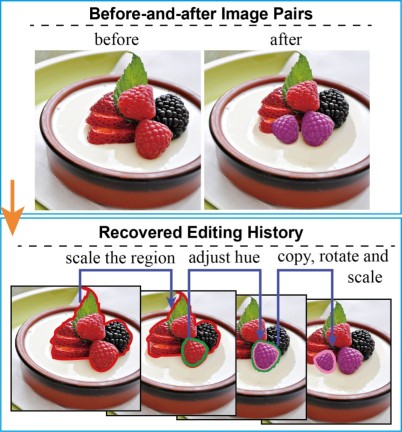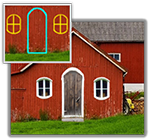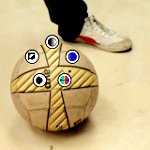
Inverse Image Editing: Recovering a Semantic Editing History from a Before-and-After Image Pair
We recover a semantically-meaningful editing history from a source image and an edited copy, which supports commonly used linear and non-linear geometric and color transforms with spatially varying adjustment brushes. User study suggests that our recovered histories are semantically comparable to the ones by artists.
Shi-Min Hu, Tsinghua University
Kun Xu, Tsinghua University
Li-Qian Ma, Tsinghua university
Bin Liu, Tsinghua University
Bi-Ye Jiang, Tsinghua University
Jue Wang, Adobe Research

3-Sweep: Extracting Editable Objects from a Single Photo
We introduce an interactive technique for manipulating simple 3D shapes based on extracting them from a single photograph. The extracted 3D object can be quickly edited and placed back into photos or 3D scenes, permitting object-driven photo editing tasks which are impossible to perform in image-space.
Tao Chen, Tsinghua University
Zhe Zhu, Tsinghua University
Ariel Shamir, Interdisciplinary Center (IDC) Herzliya
Shi-Min Hu, Tsinghua University
Daniel Cohen-Or, Tel Aviv University

PatchNet: A Patch-based Image Representation for Interactive Library-driven Image Editing
We introduce PatchNets, a compact, hierarchical representation describing structural and appearance characteristics of image regions, for use in image editing. This PatchNet representation can be used as a basis for interactive, library-driven, image editing.
Shi-Min Hu, Tsinghua University
Fang-Lue Zhang, Tsinghua University
Miao Wang, Tsinghua University
Ralph Martin, Cardiff University
Jue Wang, Adobe Research

A Sparse Control Model for Image and Video Editing
We proposed a new edit propagation approach that automatically determines the influence of edit samples across the whole image jointly considering spatial distance, sample location, and appearance. It greatly reduces the number of samples while allowing for a decent level of global and local manipulation and reducing propagation ambiguity.
Li Xu, The Chinese University of Hong Kong
Qiong Yan, The Chinese University of Hong Kong
Jiaya Jia, The Chinese University of Hong Kong

WYSIWYG Computational Photography via Viewfinder Editing
We describe a framework for interactively editing images or videos directly on a live viewfinder of a camera before or during capture. The viewfinder reflects the global and local edits the user has specified, helping the user frame her shot. The edits also guide the parameter selection for stack photography.
Jongmin Baek, Stanford University
Dawid Pająk, NVIDIA Research
Kihwan Kim, NVIDIA Research
Kari Pulli, NVIDIA Research
Marc Levoy, Stanford University






